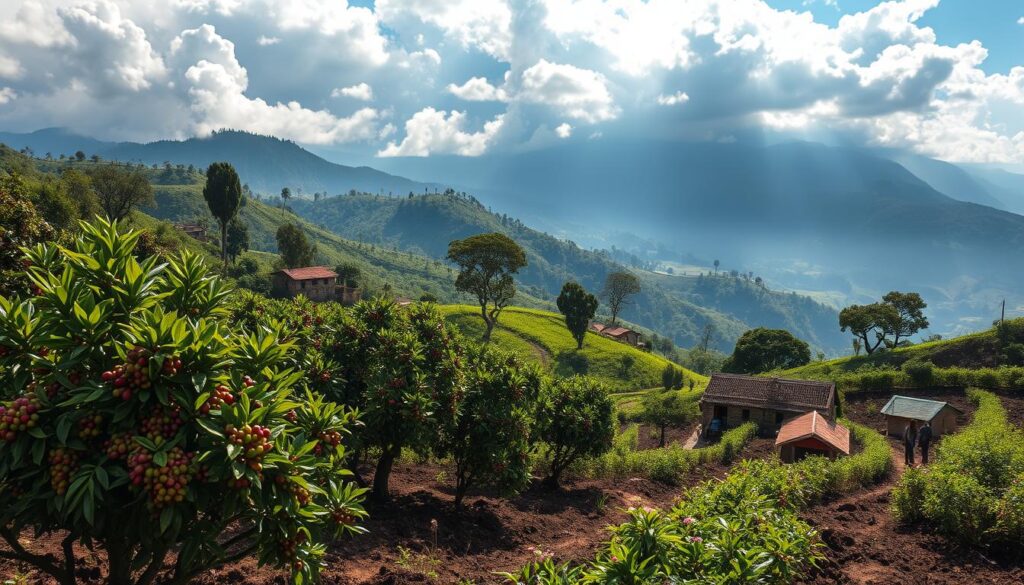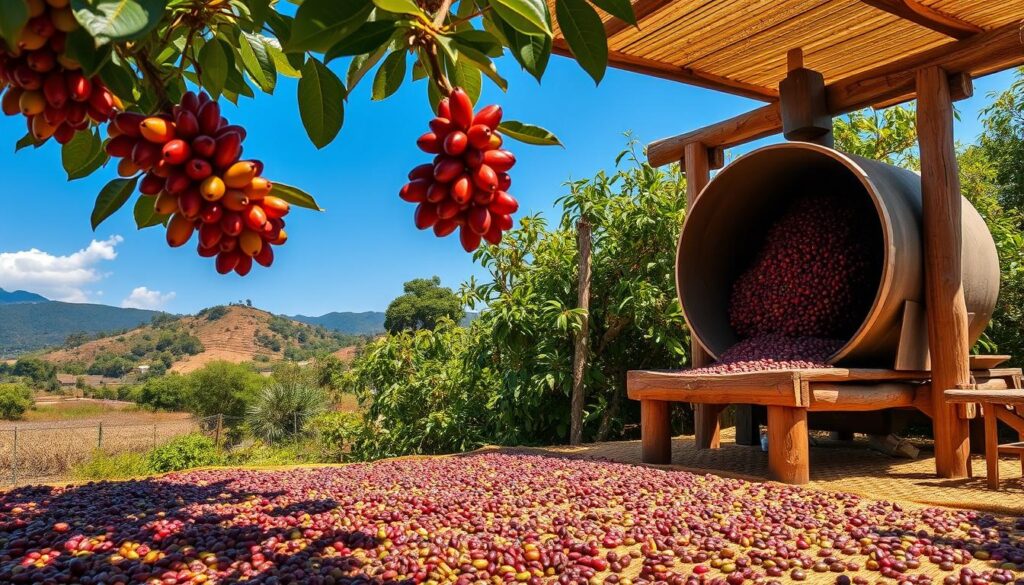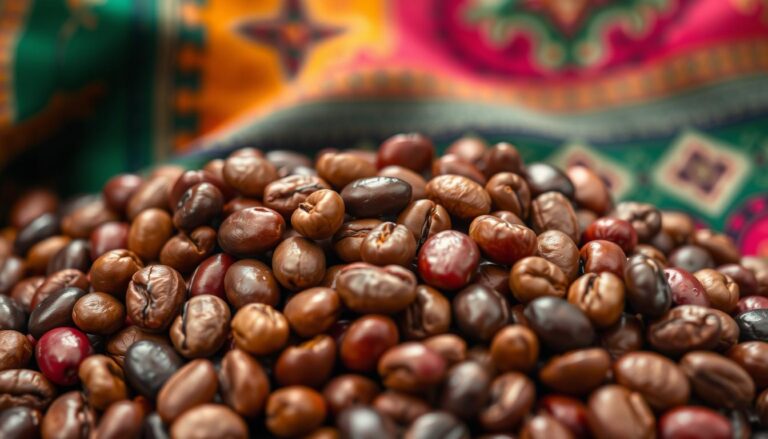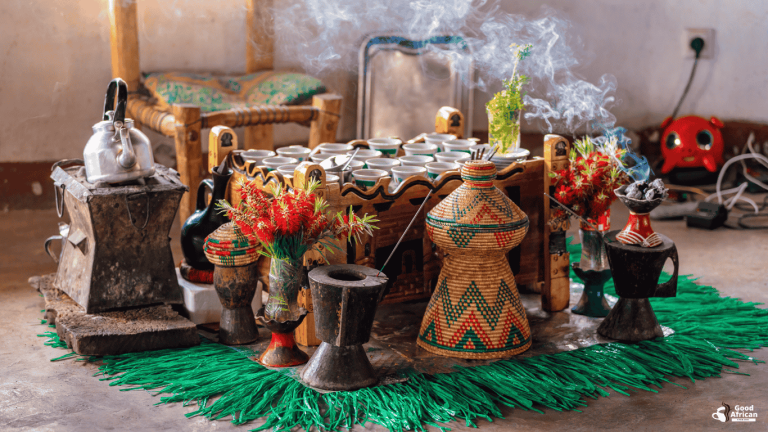Imagine walking into a cozy café, where the smell of fresh coffee greets you. This is no regular coffee—it’s Ethiopian coffee, a treat for your senses. Ethiopia, where coffee was first discovered, has mastered growing some of the world’s best coffee beans.
Ethiopian coffee is famous for its lively flavors, mixing fruity and floral notes. These beans grow in Ethiopia’s mountains. The acidic soil, high altitudes, and perfect rainfall help them thrive and develop their unique taste.
Ethiopian coffee stands out for its high acidity. This acidity brings out the coffee’s bright, fruity, and floral tastes. The flavor changes based on how the coffee is processed. Natural sun-dried coffees taste like wine or fruit, while washed coffees have hints of lemongrass and jasmine.
Key Takeaways
- Ethiopian coffee is known for its vibrant, fruity, and floral flavor profile
- The higher acidity in Ethiopian coffee brings out bright, complex notes
- Processing method significantly impacts the final flavor, with natural and washed coffees having distinct characteristics
- Ethiopian coffee beans are cultivated in the country’s mountainous regions, where they grow well
- The tradition of coffee is deeply ingrained in Ethiopian culture, with elaborate coffee ceremonies lasting for hours
A Brief Overview of Ethiopian Coffee
The history of Ethiopian coffee goes back to around 850 AD. A goat herder named Kaldi found the coffee plant’s magical benefits. Ethiopia, where coffee was first found, has a perfect environment for coffee trees to grow naturally.
The Origins of Ethiopian Coffee
Ethiopia has about 5,000 wild Arabica coffee varieties, UNESCO says. The southern mountains have great soil and lots of plants. Most Ethiopian coffee grows in the shade, giving it a special taste.
The Coffee Plant Varieties Found in Ethiopia
- Ethiopia is currently home to around 5,000 wild Arabica coffee varieties.
- Different types of Ethiopian coffee beans include Arabica, Robusta, and Heirloom.
- Varieties of Ethiopian coffee beans include Harrar, Yirgacheffe, Sidamo, and Limmu, each with its own taste.
The Ethiopian coffee industry is deeply rooted in tradition. Coffee ceremonies are a big part of the culture. In the 1960s, Ethiopia started using modern farming for coffee. This led to more Ethiopian coffee exports in recent years.
“Ethiopia is believed to be the country of origin of coffee and is deeply intertwined with the culture and heritage of the country.”

Flavor Profiles of Ethiopian Coffee
Ethiopian coffee is known for its rich and varied flavors. These flavors change based on where it’s from and how it’s made. From bright citrus to soft floral hints, Ethiopian coffee offers a unique taste adventure.
Common Taste Notes
Here are some common flavors found in Ethiopian coffee:
- Citrus fruits: Bright and zesty flavors of lemon, orange, and grapefruit.
- Stone fruits: Subtle sweetness reminiscent of peach, apricot, and plum.
- Berries: Jammy, sweet-tart notes of blueberry, blackberry, and raspberry.
- Floral: Delicate aromas and flavors of jasmine, lavender, and hibiscus.
How Processing Affects Flavor
The way Ethiopian coffee is processed greatly influences its taste. Natural processing brings out bold, fruity flavors like blueberry and chocolate. It also gives the coffee a thick, syrupy feel.
Wet processing, or washing, makes the coffee taste cleaner and brighter. It has a lighter feel and more acidity.
Each region in Ethiopia adds its own twist to the coffee’s flavor. Yirgacheffe, Guji, Sidamo, and Limu are known for their unique tastes. Knowing these differences can help you find your favorite Ethiopian coffee.

“The flavors of Ethiopian coffee are a symphony of complexity, with each region and processing method contributing its own unique notes to the overall composition.”
Brewing Methods for Ethiopian Coffee
There are many ways to brew Ethiopian coffee. The traditional Ethiopian coffee ceremony is a 2-3 hour ritual. It involves roasting, grinding, and brewing coffee over an open fire. This ceremony is a big part of Ethiopian culture, where families come together to enjoy the coffee.
Traditional Ethiopian Coffee Ceremony
The traditional Ethiopian coffee ceremony is a detailed process. It starts with roasting green coffee beans over an open flame. Then, the beans are ground with a mortar and pestle. The ground coffee is brewed in a jebena, a traditional pottery vessel.
The coffee is served in three rounds, each weaker than the last. This lets you fully enjoy the coffee’s complex flavors.
Popular Brewing Techniques in the U.S.
In the U.S., there are several popular ways to brew Ethiopian coffee. These include:
- Automatic drip: This method makes brewing easy and allows for a full pot of coffee.
- Pour-over: Using a Chemex or V60, you can control the brewing to bring out the coffee’s bright acidity and flavors.
- Cold brew: Steeping the coffee in cold water for hours creates a smooth, low-acid brew that highlights Ethiopian coffee’s unique qualities.
When brewing Ethiopian coffee, it’s important to talk to the roaster. They can help you choose the right roast for your brewing method. This ensures you get the best out of these exceptional coffee beans.
Tips for Enjoying Ethiopian Coffee
To enjoy Ethiopian coffee fully, pair it with foods that bring out its flavors. Ethiopian coffee’s light to medium body and bright acidity make it great with many foods. Look for coffee from reputable brands that focus on quality and sustainability.
Pairing Foods with Ethiopian Coffee
Ethiopian coffee’s floral and fruity notes go well with light dishes. Enjoy it with fresh fruit salads, sweet pastries, or savory dishes with herbs. Its high acidity also pairs well with creamy desserts, like chocolate.
Recommended Ethiopian Coffee Brands
For the best taste, choose freshly roasted Ethiopian coffee beans from trusted brands. Brands like Intelligentsia, Starbucks Reserve, and Koffee Kult offer great options. Use filtered water and grind the beans just before brewing to enhance the coffee’s aroma and taste.







